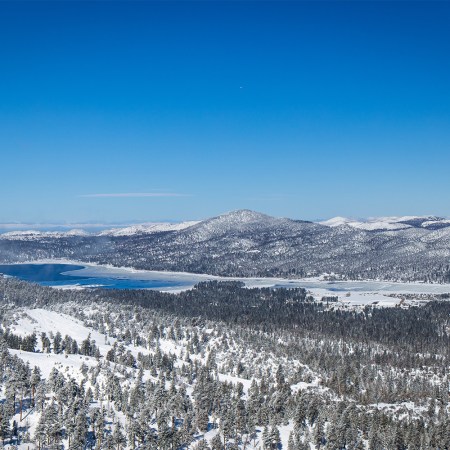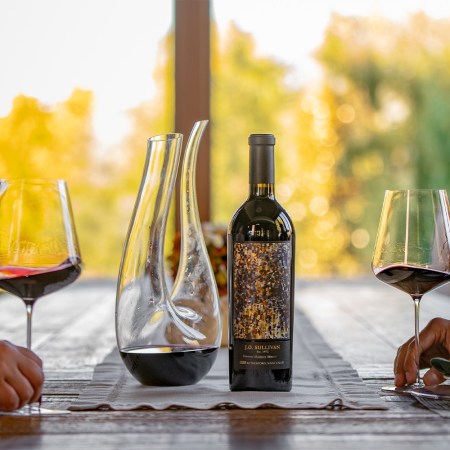Guess how many pounds of trash volunteers hauled from Lake Tahoe during a recent scuba cleanup? 25,000 pounds. Yes, that’s thousands of pounds of trash, thrown into the lake by visitors who flock there for the clarity of its crystal-clear water. That’s a bit of cognitive dissonance, to say the least. Jeff Cowen, the public information officer for the Tahoe Regional Planning Agency, is tasked with both preserving the lake’s irreplaceable environment and getting the word out about sustainable practices. Including picking up after ourselves.
“People seem to arrive, they leave stuff on the beach, and think there’s someone here to clean it up,” Cowen tells InsideHook. “Unfortunately it’s us — it’s the locals. People who go out and do beach cleanups, we’re the ones that end up picking up all this trash. But it doesn’t have to be that way. If you take the Traveler Responsibility Pledge, and dedicate yourself to trying to leave the environment better than you found it, then you’re part of the sustainable future of tourism. It’s just about being responsible with your trash.”
That pledge is one of the many ways that organizations like TRPA are trying to combat an influx of new visitors and residents in the area, and it touches on everything from litter to keeping wildlife wild and — top of mind this time of year — obeying fire safety laws. The concern is that the lake is a victim of its own social media-fueled success, and increased pressure on this national treasure is increasingly worrying the activists who are trying to maintain its beauty.
People on both sides of the state line are working to keep the lake as blue as years past — even as the number of day-trippers, visitors and locals continues to grow. “There’s a mega-region of Northern California and northern Nevada where those population centers are growing exponentially, and they’re not going to stop,” Cowen explains. “That growth is bringing additional pressure. And that’s why we started working on this — we know that those impacts around tourism and outdoor recreation are going to keep growing, so we needed to come together to manage it better.”
The additional pressure on the ecosystem of the lake comes in the form of surging litter and pollution, more transportation and traffic, and, one of the biggest concerns across the state, the increase of wildfires — often inadvertently started by tourists. “The Lake Tahoe Forest Action Plan evaluated fire ignitions in the basin and found that there were 350 fire ignitions over a seven-year period,” Cowen says. “That’s a pretty small watershed, we’re only talking 22,000 acres of land to have 350 fire ignitions, and 90 percent of those were caused by illegal campfires. So encouraging stewardship and better behavior among outdoor recreationalists is key.”
The uptick in wildfires is a particular cause for concern, not just because of the increased frequency of the fires, but also because of the severity level. Susie Kocher, a forestry advisor and registered professional forester in the region, explained that acreage itself isn’t even the whole story when it comes to wildfire damage to the ecosystem. “In the last five years, we’ve had incredible wildfire seasons with large areas being burned,” Kocher tells InsideHook. “But more importantly, a lot of those areas are burned at high severity. So the acreage burned itself is not a very good metric — it’s really the large areas burned at high-severity, where all the trees are killed and all the duff and understory is killed as well, that we have the biggest concerns about as foresters.”
Since that acreage and the high-severity percentage have been increasing exponentially in the last five years, there’s growing concern about what impact the fires will have on the lake itself. There’s a long history of research into how sediment and runoff impact Lake Tahoe’s clarity, and the uptick in wildfires will likely have an effect in that regard. Cowen notes that the ash outfall from longer fire seasons and megafires in the Sierra Nevadas could get into the lake, and Kocher cites the fear that the wrong wildfire in the wrong place could lead to a lot of sediment input into the lake.
A few years ago, groups like the Lake Tahoe Fire Adapted Communities Guide adopted the slogan “healthy forest, healthy lake” to help visitors and locals understand the connection between the two and the ecosystem as a whole. Since the added pressure of impact from wildfires is almost entirely due to human carelessness, more people — whether transplants or tourists — continues to be a chief concern. That’s why TRPA has been working on their “destination stewardship” initiative since before 2019, with the responsible traveler pledge as a key component, along with an emphasis on sustainable recreation and tourism from all sides — meaning they need hospitality partners in the area to buy in, too.
One trailblazer in the space is The Ritz-Carlton, Lake Tahoe, whose footprint in the area includes The Lake Club, a waterside venue on the north shore of the lake built in 2017, along with their mid-mountain hotel. The hotel offers packages that include guest access to their Lake Club and activities like a boating day trip and picnic on the lake. Vacation packages offering these amenities often pop up as an incentive at annual fundraisers hosted by the local non-profit, League to Save Lake Tahoe, better known by their iconic slogan: Keep Tahoe Blue. As one of the West Coast’s most recognizable environmental nonprofits, the League has been protecting the lake since 1957 by fighting overdevelopment, and working to restore the ecosystem by combating pollution and litter. With that in mind, The Ritz-Carlton also partners with them twice a year for Keep Lake Tahoe Blue clean-ups. The hotel’s staff participates, and guests are encouraged to take part.
“Tahoe is a natural wonder, and a four-season playground,” says Chris Joseph, the communications director at Keep Tahoe Blue. “Though it’s as unique as some of our country’s most storied national parks — and sees three times the annual visitors as Zion or Yellowstone — Tahoe is not a national park and lacks the same funding and protections. In recent years, local destination management organizations and their members have embraced a stewardship mindset, but more is needed to preserve Tahoe for future generations.”
Both the North Lake Tahoe Resort Association and the Lake Tahoe Visitors Authority on the south shore have stewardship pledges that they’ve created and signed onto, and are now using as part of their own branding and tourism message. Hospitality partners are essential leaders in the space, too, communicating the importance of stewardship and sustainable tourism to their own guests. And chief among those concerns remains the importance of wildfire safety.
“What we saw during the pandemic was a big increase in visitors, including visitors in the backcountry,” Kocher says, “And with that, a big increase in fire starts. That’s really the biggest concern I have with this huge uptick in tourism — that we’re going to get a fire start on the wrong day, in the wrong place. Following the fire rules, right now, is the most important thing people who are visiting can do. To make sure we don’t start a fire that’s going to burn the forest and affect the lake.”
Joseph echoes Kocher’s concerns, while also laying the groundwork for what visitors and hospitality partners should be doing instead. “The center of gravity for Tahoe’s thriving tourism industry is the lake, the forests, and the mountains,” he says. “Pristine natural beauty is why more than 15 million people visit each year. Anyone can become a #TahoeBlueGooder by taking small actions that protect the lake. Refuse single-use items and choose reusables. Make sure all your trash is disposed of properly inside a sealed trash can or dumpster. Volunteer an hour of your time to heal the ecosystem. Leave Tahoe better than you found it — however you can.”
Visit Keep Tahoe Blue to find the opportunity for you.
This article was featured in the InsideHook SF newsletter. Sign up now for more from the Bay Area.






















